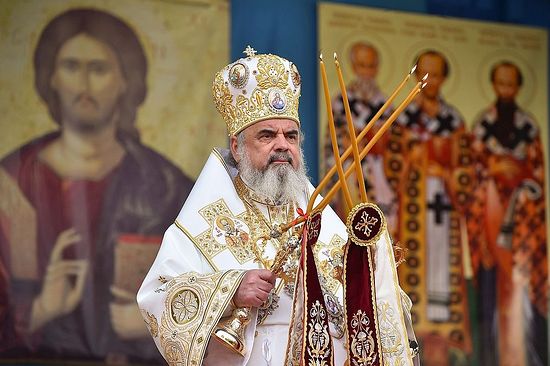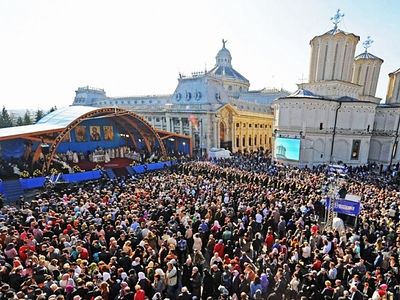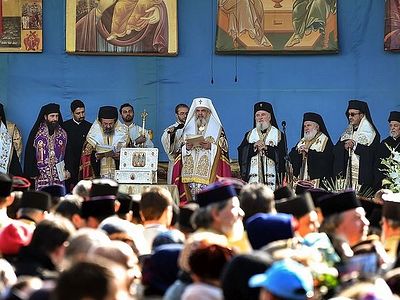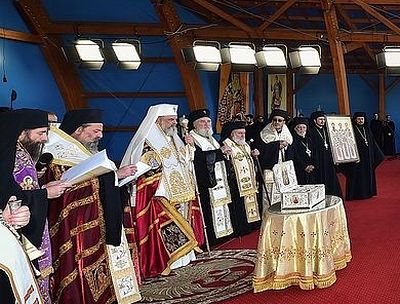Source: Basilica News Agency
October 27, 2015
St. Demetrius the New, Protector of Bucharest, whose holy relics lie in the Patriarchal Cathedral in Bucharest was celebrated on October 27. On this occasion, the Divine Liturgy was celebrated at the outdoor altar next to the Patriarchal Cathedral by His Beatitude Daniel, Patriarch of Romania, together with His Eminence Pavlos, Metropolitan of Drama.
Also concelebrating were the following hierarchs, members of the Holy Synod of the Romanian Orthodox Church:
• His Eminence Teofan, Metropolitan of Moldova and Bucovina;
• His Eminence Laurenţiu, Metropolitan of Transylvania;
• His Eminence Andrei, Metropolitan of Cluj, Maramureş and Sălaj;
• His Eminence Irineu, Metropolitan of Oltenia;
• His Eminence Ioan, Metropolitan of Banat;
• His Eminence Iosif, Romanian Orthodox Metropolitan of Western and Southern Europe;
• His Eminence Hon Metropolitan Nifon, Archbishop of Târgoviște and patriarchal exarch;
• His Eminence Teodosie, Archbishop of Tomis;
• His Eminence Irineu, Archbishop of Alba Iulia;
• His Eminence Vasranufie, Archbishop of Râmnic;
• His Eminence Ioachim, Archbishop of Roman and Bacău;
• His Eminence Calinic, Archbishop of Argeş and Muscel;
• His Eminence Ciprian, Archbishop of Buzău and Vrancea;
• His Eminence Casian, Archbishop of Lower Danube;
• His Eminence Timotei, Archbishop of Arad;
• His Grace Corneliu, Bishop of Huşi;
• His Grace Lucian, Bishop of Caransebeş;
• His Grace Sofronie, Bishop of Oradea;
• His Grace Nicodim, Bishop of Severin and Strehaia;
• His Grace Vincenţiu, Bishop of Slobozia and Călăraşi;
• His Grace Andrei, Bishop of Covasna and Harghita;
• His Grace Ambrozie, Bishop of Giurgiu;
• His Grace Visarion, Bishop of Tulcea;
• His Grace Petroniu, Bishop of Sălaj;
• His Grace Siluan, Romanian Orthodox Bishop of Hungary;
• His Grace Siluan, Romanian Orthodox Bishop of Italy;
• His Grace Timotei, Romanian Orthodox Bishop of Spain and Portugal;
• His Grace Macarie, Romanian Orthodox Bishop of Northern Europe;
• His Grace Mihail, Romanian Orthodox Bishop of Australia and New Zealand;
• His Grace Varlaam Ploieşteanul (of Ploieşti), Vicar Bishop to the Romanian Patriarch;
• His Grace Ilarion Făgărăşanul (of Făgăraş), Vicar Bishop to the Archbishopric of Sibiu;
• His Grace Paisie Lugojeanul (of Lugoj), Vicar Bishop to the Archbishopric of Timişoara;
• His Grace Sofian Braşoveanul (of Braşov), Vicar Bishop to the Romanian Orthodox Archbishopric of Germany, Austria and Luxembourg;
• His Grace Emilian Lovişteanul (of Lovişte), Vicar Bishop to the Archbishopric of Râmnic;
• His Grace Iustin Sigheteanul (of Sighet), Vicar Bishop to the Romanian Orthodox Bishopric of Maramureş and Sătmar.
The liturgical responses were offered by the Nicolae Lungu choir of the Romanian Patriarchate.
Many important state and local dignitaries, priests and deacons of the Archbishopric of Bucharest participated, and thousands of faithful pilgrims also took part in the celebration, patiently waiting on the hill of the Romanian Patriarchate to bow down before the holy relics placed in the canopy next to the Patriarchal Cathedral.
We honor today a saint well-pleasing to God, a prayerful saint
In his sermon the Romanian Patriarch spoke of the veneration of saints. His Beatitude Patriarch Daniel underlined the fact that “when we venerate relics of saints, we do not honor bones, as mistakenly believe unprepared, uninformed and ill-intentioned people, but we meet the saint whose relics are placed in front of us.”
When we venerate the holy icons we do not honor wood, but the person depicted thereon. Therefore, pious believers, who feel the presence of the grace of the Holy Spirit who prays in the saints, rejoice, while those who do not have faith and godliness are disturbed when meeting the icons or relics of the saints. Saints do not compete with Christ, but they show that the holiness of the One Who is alone Holy is conveyed to the people who believe in Him and love Him. We do not venerate the simple human nature of the saints, but the holy and sanctifying grace of God, which is present and works in the human nature. Therefore we utter together with the Psalmist: God is wondrous in His Saints, because God’s holiness is conveyed to the saints and He works through the saints, for saints are His closest friends and those who loved Him verily and wished to be in His presence. When we venerate relics of saints we meet their person who is present by grace in the holy relics. Firstly, the grace of the Most Holy Trinity is present in the soul of the saints through prayer, fasting, labors, and partaking of the Holy Mysteries, while the holiness of the soul passes to the body, and at once with the sanctification of the soul begins the sanctification of the body,
His Beatitude Patriarch Daniel said.
Only the spiritual man who is bound to God by faith and love can understand spiritual things
The Patriarch also mentioned that we venerate the holy and sanctifying grace present in the soul of the saint which is in Heaven and also in his body on earth:
Fr Dumitru Stăniloae said that there is a mysterious relation between the soul of the saints in Heaven and their icons and relics on earth, because as the soul deepens in the love and unlimited holiness of God in the same manner a part of the holiness of the soul is communicated to the holy icons and relics of their respective saints. That is why man has to be endowed with strong faith and feel the presence of God in his life and in the world. St. Paul the Apostle says that the natural, worldly, self-sufficient man cannot understand spiritual things. Only the spiritual man who is bound to God by faith and love can understand spiritual things. And here we can see this binding on the faces of the pilgrims who after standing in line several hours and waiting with prayer and with piety to bow down before the relics of saints have such great joy that they forget their labor, the cold outside, the exhaustion of traveling so far to get here. This joy, the joy of the Holy Spirit, is the great secret of the crowds of believers who love the saints and venerate them.
The believers who come here are witnesses of the presence of the grace of the Holy Spirit in the relics of the saints. Therefore, our people used to say that they do not pray to the saint who does not help, but they pray to the saint who helps, and those who have been helped by the prayers of the saints become friends with the saints. So, this piety is a bond of friendship; there is such a familiarity between saints and those who venerate them that next to saints the faithful feel as within a family of the joy of the Holy Spirit, of the love of the Most Holy Trinity. That is why we have to explain to those who do not know, because there is a strong need for catechesis, especially for adults. Children know more things about the saints than their uncatechised parents who did not attend religion class. Therefore, we have to unite theological thinking and the spiritual experience of feasts and pilgrimages.
During pilgrimage, God and the faithful look one for the other and meet spontaneously and mystically.
Furthermore, His Beatitude indicated that “pilgrimage represents a journey to a place where the love and holiness of God had been especially revealed:”
Pilgrimage is undertaken to the holy places in the footsteps of our Savior Jesus Christ, to the places where holy people lived, to the places where relics of saints or wondrous icons of saints exist. Pilgrimage is defined by this encounter with holiness. In the history of mankind, in all religions of the world, we find that pilgrimage is a special spiritual practice practice. Therefore we can assert that pilgrimage is a constant of humanity. Why do people feel the need for being travelers, to pursue holiness? Because man is created in the image of God the Only Holy One and the pursuit of holiness brings man joy. He is made to pursue God because he is created in the image of God. Once set out on the pursuit of holiness man looks also for the permanent eternal life, especially when he feels his transitoriness. He then looks for the One Who is un-transitory. The body is transitory but the soul is immortal. That is why the immortal soul pursues the eternal God. The great mystery of pilgrimage is that God also looks for man. On pilgrimage God and the faithful look one for the other and meet spontaneously and mystically.
Pilgrimage is man’s answer to God’s mystical call
The Patriarch offered some examples of pilgrimages recorded in the Old and New Testament and explained that “every pilgrim travels together with Christ in the pursuit of holiness; Christ meets them and offers Himself to the pilgrims in the Holy Eucharist.”
Abraham was called by God to leave his country full of idols, Ur of the Chaldees, and go to Canaan, to an unknown land; but being full of faith, Abraham answered to God and became a pilgrim to Canaan, where he lived a while and met God-the-Pilgrim at the Oak of Mamre. Suddenly three persons appeared to Abraham, as the book of Genesis recounts in the 18th Chapter. We see the one who was looking for God was sought by God-the-Pilgrim. Our Lord Jesus Christ is born during a journey, on a pilgrimage undertaken by Righteous Joseph and the Virgin Mary to Bethlehem. Then, His entire earthly life He traveled to all cities and villages, healing all kinds of sickness and disease, preaching the Gospel of the Kingdom of Heaven, and almost every trip to the Holy Land had Jerusalem as the final destination. Jesus’ last pilgrimage to Jerusalem ended with His crucifixion and resurrection. With His resurrection He finished His earthly pilgrimage, and became a pilgrim in the heavenly Jerusalem. Nevertheless, even from the heavenly Jerusalem the resurrected Christ became an unknown pilgrim on the way from Jerusalem to Emmaus together with Luke and Cleopas. And the pilgrimage to Emmaus ended with the partaking of the Holy Eucharist. After He blessed the bread and broke it, He gave it to His disciples, and then disappeared because He hid Himself in the Eucharistic bread. And so, every pilgrim travels together with Christ in the pursuit of holiness; Christ meets them and offers Himself to the pilgrims in the Holy Eucharist.
Pilgrimage is also a moment of gratitude offered to God for the benefits received from Him
“Pilgrimage is the pursuit of holiness,” His Beatitude also underlined:
Pilgrimage is undertaken in order to strengthen our faith, from the faith of others whom we see during pilgrimage praying more, who are more pious and humble; we learn from others’ piety. Pilgrimage is also a moment of gratitude offered to God for the benefits received from Him. Pilgrimage is also an act of repentance for our sins, an act of supplication of the remission of sins. We ask the saints to help us love God as they have loved Him and to grant us strength so that being travelers in this world we can finally reach the heavenly homeland, the definitive heavenly city.
At the end of the Divine Liturgy, the Romanian Patriarch thanked His Eminence Metropolitan Pavlos of Drama for coming to Romania and awarded him as a sign of blessing and appreciation a medal of the Order St John Chrysostom, and an icon of St. John Chrysostom.
Next, His Eminence Metropolitan Pavlos delivered a speech referring to the activity of His Beatitude Patriarch Daniel and the good relations between Romania and Greece over the years. The Metropolitan of Drama offered the Romanian Patriarch a pectoral cross, a replica of the reliquary cross containing the fragment of the Precious Wood of the Holy Cross of Christ kept in St. Paul Monastery of holy Mount Athos, as well as a hierarchical Panagia.
Finally, His Beatitude Patriarch Daniel thanked all the hierarchs present and everyone involved in the organization of the feast of the Patriarchal Cathedral: central and local authorities, clergy, monastics, professors, theological students, police and volunteers from various medical organizations.




